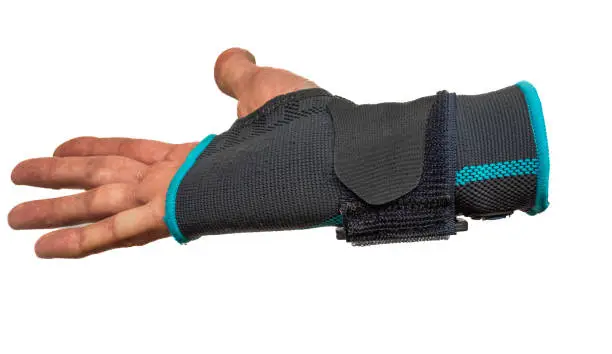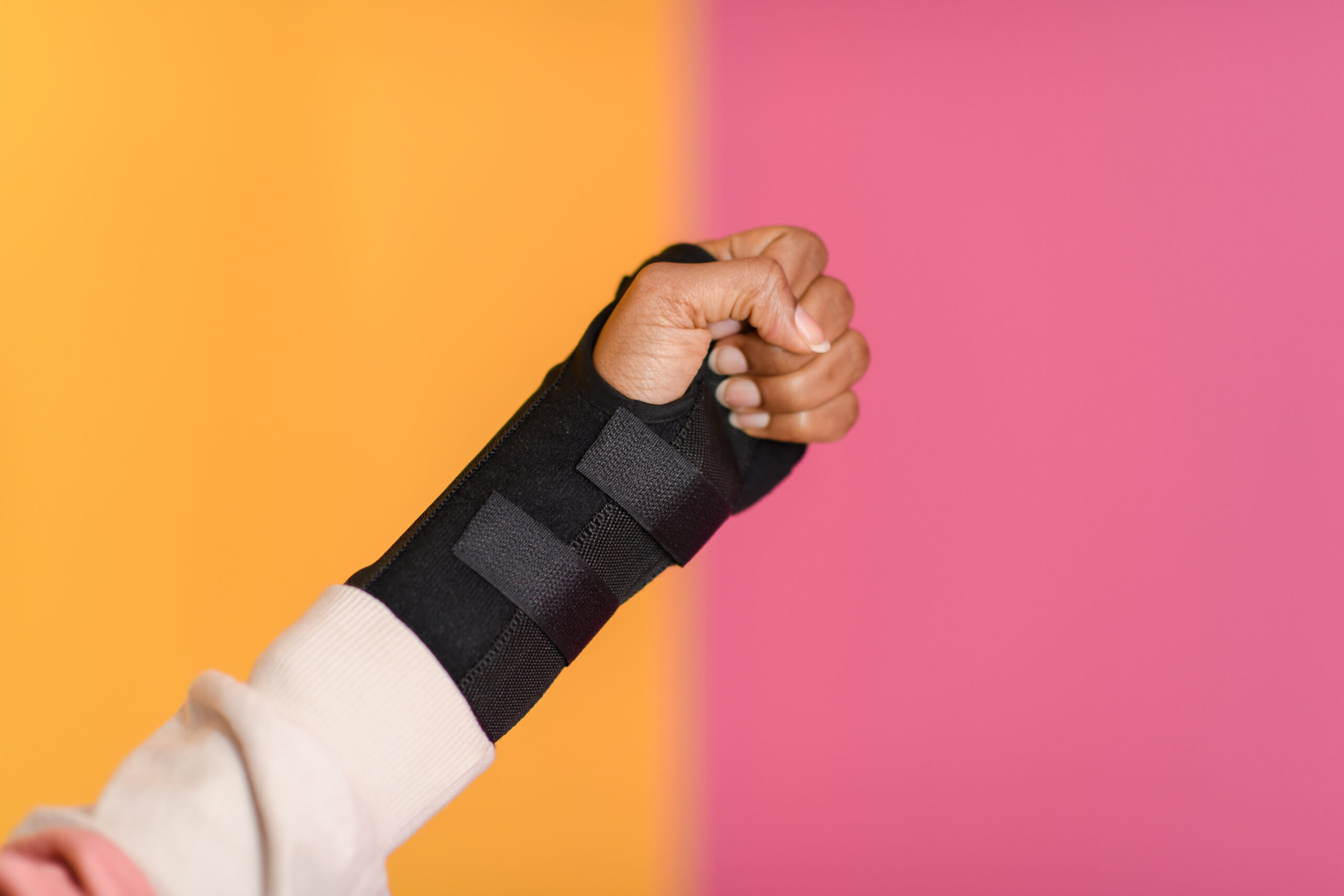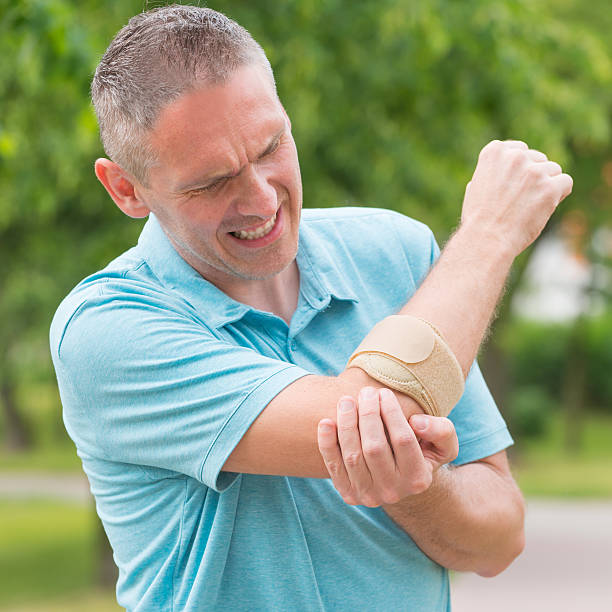Have you ever woken up in the middle of the night with that weird pins-and-needles feeling in your hand? Or maybe by the end of a long day, your wrist is just aching—like it’s had enough? If that sounds familiar, you’re in good company. Carpal tunnel can creep up on anyone, whether you’re typing all day, cutting hair, fixing cars, holding a baby, or just constantly on your phone.
It’s not just an annoying twinge—it can mess with your sleep, make simple things harder, and honestly just wear you down over time.
I know the feeling because I’ve been through it too. I’ve done the whole routine—wearing a wrist brace to bed, stretching like I’m warming up for a workout before I type, even changing how I scroll on my phone. So if you’re here, trying to find something that actually helps, I totally get it.
One of the easiest and most helpful things I found? A good wrist brace. But not just any one off the shelf—the right one can make a big difference. It gently keeps your wrist in a neutral position, which takes the pressure off that pesky median nerve (yep, that’s the one causing all the tingling, numbness, and pain). Some braces are made for nighttime to stop your wrist from curling up while you sleep. Others are softer and easier to wear during the day—so you can keep going without feeling like you’re wearing a robot arm.
The trick is finding one that actually works for you. Your day, your routine, your comfort. Maybe you need something breathable to wear at work. Or something sturdier for sleep. It’s about finding that sweet spot between support and comfort.
In this guide, I’ll share the best wrist braces for carpal tunnel—based on real-life experiences, honest reviews, and the stuff that really matters. Whether your symptoms are just getting started or you’ve been dealing with this for a while, there’s something out there that can make things feel better.
Let’s find the right one together.
Out of curiosity—what do your days usually look like? What’s putting the most strain on your wrist?
Benefits of Using Best Tennis Elbow Support Brace
Living with tennis elbow—whether you’re actually swinging a racket or just spending long hours typing or lifting—can be incredibly frustrating. That sharp, nagging pain on the outside of your elbow doesn’t just affect your ability to play sports; it can creep into your everyday life, making simple tasks like pouring a cup of coffee or opening a door feel like a chore. This is where a quality tennis elbow support brace can make a real difference.
- Pain Relief You Can Feel
The most immediate and noticeable benefit of using a good tennis elbow brace is pain relief. These braces apply targeted compression to the forearm muscles and tendons, which helps reduce strain on the inflamed area. By absorbing stress before it reaches the injured tendon, a brace can significantly ease discomfort—especially during activities that would otherwise aggravate the condition. Many users describe the feeling as “instant support,” like someone’s finally holding your arm together.
- Support During Movement
A common misconception is that braces just immobilize your arm. The truth is, the best tennis elbow braces allow for movement while still providing enough support to prevent overuse. Whether you’re working out, gardening, typing, or playing sports, the right brace stabilizes the joint without making you feel restricted. That balance can mean the difference between pushing through pain and enjoying your day pain-free.
- Faster Recovery
Rest is essential, but proper support can accelerate the healing process. By reducing repetitive strain and allowing microtears in the tendon to heal undisturbed, a brace gives your body the best shot at recovery. Think of it as a gentle reminder to your arm to go easy—while still letting you keep up with your responsibilities.
- Injury Prevention
Even if you’re just starting to feel the first signs of tennis elbow, using a brace early can help prevent the condition from worsening. It’s not just for recovery; it’s also a great preventative tool. If your job or hobbies involve repetitive arm movements, wearing a brace during those activities can reduce your risk of injury.
- Confidence to Stay Active
There’s a huge mental benefit, too. When you’re dealing with chronic or recurring pain, it’s easy to hesitate—whether it’s lifting weights, shaking hands, or even just doing chores around the house. Wearing a support brace can boost your confidence, letting you trust your arm again without worrying that every motion might lead to a flare-up.
- Comfortable for Daily Wear
Today’s best elbow braces are designed with comfort in mind. Breathable materials, adjustable straps, and ergonomic designs mean you can wear them for extended periods without irritation. Some are even sleek and low-profile enough to fit under clothing, so you can get discreet support throughout your workday or during travel.
- A Small Investment for Big Relief
Finally, a quality tennis elbow brace is one of the most affordable ways to manage and recover from elbow pain. No pills, no procedures—just a simple tool that offers real, physical relief. For many, it’s a game-changer that turns daily pain into manageable, even forgettable, discomfort.
At the end of the day, a tennis elbow brace isn’t just about the elbow—it’s about regaining control of your body and your life. Whether you’re an athlete, an office worker, or a weekend DIYer, having the right support can help you move, work, and play with confidence again.
Importance of Using Best Tennis Elbow Support Brace
Tennis elbow might sound like something only athletes deal with, but the truth is, it can affect just about anyone. From office workers typing away at their keyboards to gardeners, painters, and even parents lifting their kids — this painful condition doesn’t discriminate. The medical name for it is lateral epicondylitis, and it stems from overuse of the forearm muscles, causing pain around the outside of the elbow. That’s where a good tennis elbow support brace can make a world of difference.
I remember when I first felt that dull ache in my elbow. At first, I ignored it, thinking it was just a little soreness from lifting too many grocery bags at once. But the pain got worse. Simple things like turning a doorknob or lifting a cup of coffee became uncomfortable. That’s when I realized I needed to take it seriously — and a support brace became my best friend.
So, why is it so important to use the best tennis elbow support brace, rather than just any one off the shelf?
- Targeted Compression and Support
The best braces don’t just wrap around your elbow; they apply gentle pressure to the right spot — the forearm muscles and tendons just below the elbow. This targeted compression reduces strain, improves blood circulation, and can significantly speed up the healing process. A poorly designed brace might feel uncomfortable or not provide enough pressure, making the problem worse instead of better.
- Pain Relief Without Medication
Many people don’t want to rely on painkillers every day, and I was one of them. A good brace offers a non-invasive, drug-free solution. It helps manage pain throughout the day, whether you’re working, exercising, or just relaxing at home.
- Keeps You Active
Stopping all activity isn’t always an option, especially if your job or daily tasks involve using your arms. The best tennis elbow braces are designed to let you move freely while still offering the support your elbow needs. You don’t have to put your life on hold while you heal.
- Prevents Further Injury
Once you’ve experienced tennis elbow, you’re at a higher risk of it happening again. A high-quality support brace can be used preventatively during activities that put stress on your forearm. Think of it like a seatbelt — it might not always be comfortable, but you’ll be glad you wore it when you need it.
- Comfort Really Matters
When you’re wearing a brace for hours at a time, comfort is crucial. The best braces are made from breathable, soft materials that won’t chafe or irritate your skin. They’re adjustable and lightweight, so you’ll barely notice them — until you take it off and feel the difference.
Living with tennis elbow can be frustrating, but the right support brace can offer real relief and help you get back to doing the things you love. It’s a small investment in your comfort and long-term health. Trust me — once you find the right one, you’ll wonder how you ever managed without it.
Have you tried using a brace before, or are you still looking for the right fit?
Types of Best Tennis Elbow Support Brace
If you’ve ever dealt with the nagging pain of tennis elbow, you know just how much it can affect your daily life. Whether you’re an athlete, a weekend warrior, or someone who works with their hands all day, that soreness on the outside of your elbow is more than just a minor inconvenience—it can throw off your whole routine. The good news? The right support brace can make a world of difference.
Tennis elbow braces aren’t one-size-fits-all. There are different types designed for different needs, lifestyles, and levels of pain. Here’s a closer look at the best types available—and how to choose the one that fits your life best.
1. Elbow Strap (Counterforce Brace)
This is perhaps the most popular and widely used type of tennis elbow brace. It’s a simple band that wraps around your forearm, just below the elbow. By applying pressure to the muscles and tendons, it reduces the strain on the injured area.
Why it’s loved: It’s lightweight, easy to wear under clothing, and great for people who want to stay active while recovering. You can put it on in seconds and adjust it on the go.
Best for: Mild to moderate pain, especially for athletes or active individuals.
2. Elbow Sleeve (Compression Brace)
This is more of a full-coverage option that fits like a snug sleeve over your elbow and part of your forearm and upper arm. It provides consistent compression, warmth, and support.
Why it’s loved: The sleeve design not only supports the joint but also improves circulation, which can help speed up healing. It’s a great all-day wear option, especially for people who experience swelling or stiffness.
Best for: Ongoing support throughout the day, mild swelling, and moderate discomfort.
3. Dual Support Brace (Strap + Sleeve Combo)
Can’t decide between a strap and a sleeve? You don’t have to. Some braces combine both—offering the compression of a sleeve and the targeted pressure of a strap.
Why it’s loved: It’s like getting the best of both worlds. You’ll get the comfort and support of the sleeve, with the ability to target specific pain points using the strap.
Best for: Moderate to severe pain, or people recovering from more intense inflammation.
4. Custom-Fit or Adjustable Braces
Some braces come with adjustable components or moldable materials to give you a more personalized fit. These are often a bit more expensive, but they’re worth it if you need tailored support or have unique elbow dimensions.
Why it’s loved: It feels like it was made just for you. You can adjust the pressure and fit as your healing progresses.
Best for: Long-term use or when off-the-shelf braces don’t quite do the trick.
Finding the Right One for You
When choosing a tennis elbow brace, think about your lifestyle, how much pain you’re in, and when you plan to wear it. Do you need something discreet for work? Or maybe something sturdier for workouts? Your brace should fit seamlessly into your life—not hold you back from it.
And one last thing—don’t be afraid to try a few different kinds. Everyone’s body is different, and what works for someone else might not be perfect for you. Listen to your body, and if in doubt, talk to a physical therapist or doctor for guidance.
Because when it comes to healing, comfort matters just as much as support.
How to care for a Best Tennis Elbow Support Brace?
If you’ve been struggling with the nagging, sharp pain of tennis elbow—whether from swinging a racket, hammering nails, or typing away at a desk—you’re not alone. Tennis elbow (lateral epicondylitis) doesn’t just affect athletes; it sneaks up on anyone who repeats certain arm and wrist movements. A good support brace can make a world of difference. But knowing how to wear it properly is just as important as choosing the right one.
Let’s break it down so you can start feeling relief and getting back to doing what you love—without the ouch.
Why Use a Tennis Elbow Brace?
Before we get into the how, it helps to understand the why. Tennis elbow braces work by applying gentle pressure on the forearm muscles, just below the elbow. This offloads strain from the irritated tendons and gives them a chance to heal. Think of it like turning down the volume on your pain dial.
Step-by-Step: How to Wear It Right
Choose the Right Brace There are a few types out there—strap braces, compression sleeves, or combo styles. The most common and beginner-friendly option is the strap-style brace, which wraps around your forearm and uses a small pressure pad.
Find the Sweet Spot Slide the brace about 1 to 3 inches (roughly 2-4 finger widths) below your elbow joint on the outer side of your forearm. This is where the affected tendon is located. Don’t guess—feel for the tender spot when you press and place the brace just below that.
Secure It Firmly—But Don’t Overdo It Tighten the brace so it feels snug but not restrictive. You should still be able to move your fingers and wrist comfortably. If your hand tingles or changes color, it’s too tight. Your goal is support, not cutting off circulation.
Wear It During Activity Braces aren’t usually meant to be worn 24/7. Put it on when you’re doing the activities that trigger your pain—working out, lifting, typing, or yes, playing tennis. Remove it afterward to give your arm a break and allow full movement.
Pair With Good Habits A brace can help manage the pain, but it’s not a cure on its own. Try icing your elbow after activity, stretching your forearm muscles, and gradually strengthening the area. And if your pain persists, don’t hesitate to see a physical therapist or doctor.
Real Talk: Listen to Your Body
Everyone’s different. Some people find immediate relief with a brace; others need to try a few styles before one clicks. Pay attention to how your arm feels. If the brace seems to make things worse, it may not be the right fit—or you might be placing it wrong.
Final Thoughts
Using a tennis elbow brace correctly can mean faster healing and less daily discomfort. It’s a simple tool, but when used properly, it helps you stay active and protect your elbow from further strain. Just remember—it’s one part of a bigger picture that includes rest, rehab, and sometimes a little patience.
Pain doesn’t have to be the price you pay for doing what you love. So go ahead, strap on that brace and take a step toward relief. Your elbow will thank you.
How Do Carpal Tunnel Braces Work?
If you’ve ever felt that familiar tingling, numbness, or pain in your hand or wrist, especially after a long day of typing or using your phone, you’re not alone. Many people experience symptoms of carpal tunnel syndrome, a condition that affects the median nerve running through your wrist. One of the most common ways to ease the discomfort—before considering surgery or more intensive treatments—is by using a carpal tunnel brace. But how exactly do these braces work?
Let’s break it down in a way that makes sense and feels relatable.
The Root of the Problem
Carpal tunnel syndrome happens when the median nerve, which travels through a narrow passage in your wrist called the carpal tunnel, gets compressed or irritated. This nerve is responsible for sensation in your thumb, index finger, middle finger, and part of your ring finger, so when it’s pinched, you feel it. That’s where the numbness, pain, and weakness in your hand come from.
Enter the Carpal Tunnel Brace
Think of a carpal tunnel brace like a gentle but firm handshake that reminds your wrist to stay in a neutral position. Most of us tend to bend our wrists while sleeping, typing, or doing everyday activities, and those repeated movements or awkward angles can aggravate the median nerve. The brace is designed to prevent those harmful motions.
Most braces are made with soft yet supportive materials and include a splint—a rigid piece that runs along the underside of your wrist—to keep your hand from bending too far forward or backward. By holding your wrist in a straight, aligned position, the brace reduces pressure on the median nerve.
Nighttime Relief
One of the most common times people wear these braces is at night. You might not realize it, but many of us sleep with our wrists curled in ways that can worsen symptoms. A brace helps keep your wrist straight while you sleep, which often leads to better mornings with less tingling and stiffness.
Daytime Use: Gentle Support
Some people also wear the brace during the day, especially when doing repetitive tasks like typing, lifting, or working with tools. It doesn’t mean you have to wear it 24/7—just during the activities that trigger your symptoms. It’s a simple, non-invasive way to protect your wrist and give your nerve some breathing room.
Not a Cure, but a Helper
It’s important to understand that a carpal tunnel brace doesn’t cure the condition. What it does is help manage the symptoms, give your wrist a break, and potentially prevent the problem from getting worse. For many people, especially in the early stages of carpal tunnel syndrome, a brace—combined with rest, stretches, and adjustments in daily habits—can make a noticeable difference.
A Small Change, A Big Impact
Using a brace might seem like a small thing, but for someone who struggles to button a shirt, type an email, or hold a coffee mug without pain, it can be a game changer. It’s a reminder that your hands work hard for you every day—and sometimes, they just need a little extra support.
If you think you might be dealing with carpal tunnel symptoms, talk to your doctor or a physical therapist. A simple brace might be the first step toward feeling better and getting your hands back to doing what you love.
Do braces actually help carpal tunnel?
If you’ve ever experienced the tingling, numbness, or sharp pain that shoots through your hand and wrist while typing or sleeping, you might be familiar with carpal tunnel syndrome. It’s a surprisingly common condition, especially among people who spend a lot of time at a keyboard, perform repetitive tasks, or even those who are pregnant or have certain medical conditions. One of the first pieces of advice you’ll often hear—sometimes even from friends who’ve “been there”—is to try wearing a wrist brace. But the real question is: do braces actually help carpal tunnel?
Let’s break it down from both a medical and real-life perspective.
What Is Carpal Tunnel Syndrome, Exactly?
Carpal tunnel syndrome happens when the median nerve, which runs from your forearm into your palm, gets compressed at the wrist. This can be caused by swelling, repetitive hand movements, or underlying health issues like diabetes or arthritis. Symptoms often sneak up gradually and can range from mildly annoying to downright painful. Many people first notice it when they wake up in the middle of the night with a numb or tingling hand.
The Role of Braces: More Than Just a Wrist Hug
A wrist brace—or splint—is designed to keep your wrist in a neutral, straight position. This position reduces pressure on the median nerve, especially during activities (like typing or using a mouse) or at night when your wrist might bend unconsciously in ways that worsen symptoms.
Many people report that wearing a brace at night brings noticeable relief. You might not realize it, but during sleep, your wrist can curl into awkward positions that put extra pressure on the carpal tunnel. A brace gently keeps everything aligned, giving the nerve a chance to rest.
In mild to moderate cases of carpal tunnel, wearing a brace consistently—especially overnight—has been shown in studies to improve symptoms significantly. In fact, doctors often recommend it as the first line of treatment before exploring more invasive options like steroid injections or surgery.
Real People, Real Relief
Ask anyone who’s dealt with carpal tunnel, and you’ll likely hear a variety of experiences. Some people swear by their braces, saying they noticed an improvement within just a few nights. Others say it took a few weeks of steady use, combined with other changes like adjusting their workspace ergonomics or taking more frequent breaks.
It’s worth noting that a brace isn’t a magic cure. If the underlying cause of the nerve compression is severe or has gone untreated for too long, a brace alone might not reverse the damage. But in many cases, it can slow down the progression, ease daily discomfort, and even help you avoid surgery altogether.
Tips for Using a Wrist Brace Effectively
- Choose the right fit. A brace that’s too tight can make things worse. You want support, not a tourniquet.
- Wear it at night. This is when most people unknowingly aggravate their symptoms.
- Try it during the day, too. If your symptoms are triggered by certain tasks, daytime use can help.
- Combine with lifestyle changes. Stretching, proper posture, and ergonomic tools go a long way.
Final Thoughts
So, do braces actually help carpal tunnel? For many people, the answer is yes—especially when used consistently and early in the course of the condition. Think of a brace as a gentle reminder to your wrist to take it easy. It’s a simple, non-invasive tool that can offer real relief, helping you get back to work, sleep, and life without the constant nagging of that pesky nerve pain.
What type of brace should I wear if I have carpal tunnel?
If you’re dealing with the tingling, numbness, or pain that comes with carpal tunnel syndrome, you’re not alone—and you’re probably wondering what kind of brace might actually help. It can be frustrating to go through daily tasks when your hand feels weak or your fingers don’t quite cooperate like they used to. The good news? The right brace can offer real relief, especially when worn consistently and correctly.
First Things First: Why a Brace Helps
Carpal tunnel syndrome happens when the median nerve, which runs through a narrow passage in your wrist (called the carpal tunnel), gets compressed. This often results from repetitive wrist movements, poor ergonomics, or certain health conditions.
A brace works by keeping your wrist in a neutral (straight) position, which helps reduce pressure on that nerve. When worn during sleep—or throughout the day during certain activities—it can significantly ease symptoms.
The Best Type of Brace: A Wrist Splint
When shopping for a brace, what you’re looking for is technically called a wrist splint. These are usually made of soft fabric but contain a rigid insert or stay that holds your wrist in a stable position. Here are a few key things to look for:
- Neutral wrist positioning: The brace should keep your wrist flat—not bent up or down.
- Comfortable fit: You want something snug, but not tight. It should support without cutting off circulation.
- Breathable material: Especially if you’ll be wearing it overnight or for long hours, you’ll appreciate fabric that doesn’t make your skin sweat or itch.
- Easy to put on and adjust: Velcro straps are common and make it easier to get the fit just right.
Some of the most recommended wrist splints for carpal tunnel include models from brands like Futuro, Mueller, and BraceUP, which you can find at most pharmacies or online.
When Should I Wear It?
If your symptoms are mild to moderate, try wearing your brace at night first. Many people sleep with their wrists curled, which can make carpal tunnel symptoms worse. By keeping your wrist straight, the brace gives your nerve a break while you rest.
If your symptoms show up during specific tasks—like typing, driving, or even holding your phone—wearing the brace during those times can also help. But remember, a brace is not a permanent solution. It’s a support tool, not a cure.
One Size Doesn’t Fit All
Every hand is different, and what works for one person may not feel quite right for another. It might take trying a couple of different models or sizes to find your perfect fit. That’s totally normal.
Also, if your symptoms persist or worsen despite wearing a brace, don’t hesitate to check in with a doctor or physical therapist. Sometimes additional treatments like exercises, ergonomic changes, or in severe cases, surgery, might be necessary.
A Small Change, A Big Difference
Wearing a wrist brace might feel like a small change, but for many people, it brings huge relief. It’s one of those simple tools that—when used correctly—can help you get back to living, working, and sleeping with less pain and more peace of mind.
After all, your hands are part of nearly everything you do. They deserve a little extra support when they’re calling out for help.















![FREETOO Wrist Brace for Carpal Tunnel,[New Upgrade-Anatomically shaped] Adjustable Wrist Support Splint for Men and Women,Hand Brace for Pain Relief, Tendinitis,Arthritis,Right Hand,Medium,Black-Grey](https://m.media-amazon.com/images/I/41fgi2rhn9L._SL160_.jpg)









